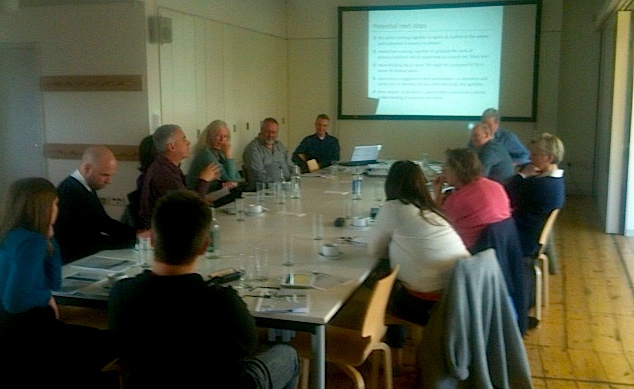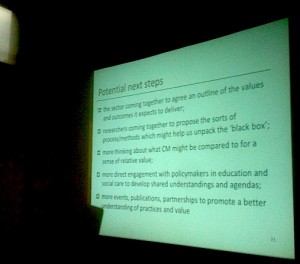‘Music is good for you’?… ‘The music [created] could be crap or not crap’…
The culmination at Whitechapel Gallery, London, of a national set of workshops for community music (CM) scholars, practitioners, policy makers and funders through 2013. These took place in Norwich, Leeds, Manchester, London. The network was funded by AHRC, and was part of the Connected Communities Programme. The function of the day: to present a report and findings produced. The report will be available soon as a downloadable PDF on the Resources page of the Connected Communities website.

Here are some notes I made on the day.
This report confirms the continuing ‘definitional reluctance’ of community music (CM). CM has a ‘chameleonic identity’—which has been seen as wilful, or strategic. My question: But how is it also, eg, after decades of activity, lazy, non-reflexive, even anti-intellectual? Or, if these are just too powerfully accusatory, at least exasperating?!
Myth-making, attractive mystery of some CM practice, not least around social impact. ‘Mysticism’ over pragmatism? ‘The appeal of the charismatic?’ An ‘opaque umbrella’? But where is the robustness of definition and understanding? Instead: a set of ‘mythologies’.
‘Quiet radicalism’, which seems to both confirm and undermine the alternative and cultural democratic history of CM. Not in fact much evidence of CM’s radicalism among today’s practitioners. The community musician as service provider rather than cultural revolutionary. GM: How can it be ‘quiet’ when CM is (sometimes) so noisy? Does any ‘quiet radicalism’ mean it loses its distinctive values and practices? Practitioners agreed on ‘unseen’ or ‘unrecognised’ outcomes of CM activities—but are they also lost, ignored? The importance of the intangible.
CM as music education: CM nowadays to an extent is accepted within formal music education, or are these still ‘uneasy bedfellows’. Is CM music education, even, or does it work through music for social education, say? Compared with formal music education (cf National Plan for Music Education), which remains more ‘obedient’, and ‘elitist’.
‘Quality’ of CM music—how do other Community / Participatory Arts address this? How does CM access and illustrate and measure evidence of quality? Anecdotes, stories and quotations abound, even in reports. Is there advocacy rather than evaluation, and sometimes ‘deliberate blurring’ by community musicians and their organisations?

How can academic researchers help? It’s such a fuzzy field, esp for the uninitiated—can there be a contribution here? This could also help articulate the benefits of CM, for funders and policy-makers, and the place of cultural value. Is a chameleonic state unconvincing to the sceptical?
